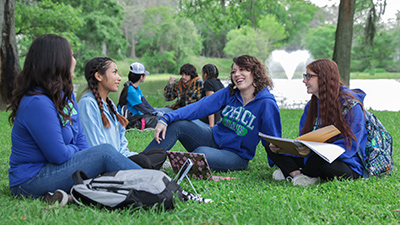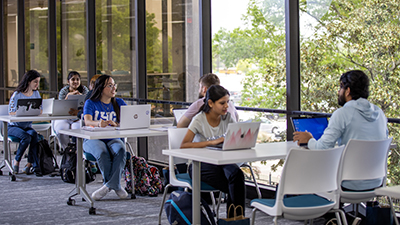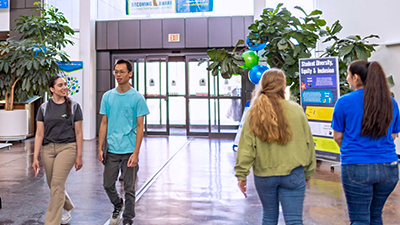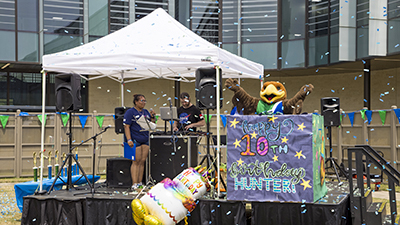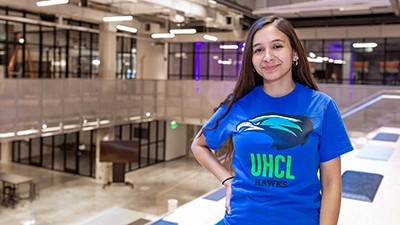
100th Day Address
Our First 100 Days ... Together
Presidential Address
November 15, 2017
Good morning, everyone! I’d like to thank you for coming to my first university-wide public address as president of the University of Houston-Clear Lake. Thank you for taking the time to be here. I also want to express my sincere gratitude for all of the kindness, support and optimism you’ve shown me, both personally and professionally. Whether in Facilities, Maintenance & Construction, Student Affairs, Administration & Finance, or Academic Affairs, staff, faculty, and students have been most welcoming and helpful. And beyond our campus, in our broader community, some of our 60 thousand Plus alumni… regional business and healthcare leaders… small business owners… heads of not-for-profit organizations… and school administrators have been generous as well and have re-pledged their support to UH-Clear Lake as we work to make our region’s future better than its present or past.
My goal today…after about 100 days of us being together… is to get us all on the same page in the same chapter of the University of Houston-Clear Lake’s history of service to the Houston-Galveston region. I also want to formally mark UH-Clear Lake’s promise as a high impact university for the 21st century. That promise will be compromised if we do not define what it means for us… what it takes for us to accomplish it… how to determine that we are actually making our desired progress… and what, where, when and how to adjust as necessary in our joint pursuit of that promise.
So, let me share with you a cliff-note version of what I’ve learned about who we are where we are and what we need to collectively track to realize our university’s promise.
Let’s begin with the lessons from Harvey the Hurricane.
As you all know, I am not a native Houstonian or a long-term resident. I actually arrived 25 days --- yes --- only 25 days before Hurricane Harvey made landfall near Rockport, Texas.
In less than one month, I had to make my first decision as president -- a major decision about whether to close the university before it actually opened for the 2017-18 academic year. Based on the wisdom of our local hurricane experts, I determined that it was prudent to delay university opening.
What happened in our service region was devastating. Harvey blew, surged and dumped water, up to an accumulated 65 inches in some neighborhoods, across the Greater Houston-Galveston Metropolitan Area. I had heard the names of many towns in our service region when I visited to find a residence, but my formal introduction to these towns were photos such as these.
But we’re talking about lessons learned.
Our campus response to Harvey was the first lesson. And, that was staff, faculty, students … pulling together with every intention of minimizing Harvey’s impact and speeding up our recovery.
Fortunately, UH-Clear Lake’s main campus, our Pearland Campus, and our program site at the Texas Medical Center did not suffer any irreparable or major damage. This information was provided daily through Harvey Status Reports from our Police Department to the campus’ Emergency Management Team. The worst of it was about 3-5 inches of water at UHCL Pearland Campus, which our facilities crew and staff, along with the help of the Alvin Community College facilities crew and basketball team, cleaned in record time.
The hidden lining of Harvey was not silver but one of UH-Clear Lake “Kevlar.” Working with UH-Clear Lake leaders on the Emergency Management Team, I learned that we are a community of care, commitment and cooperation. We are also tough!
There is a saying: “Sometimes when things are falling apart, They may actually be falling into place.” - Unknown
Our response to Harvey taught me that when we move in the same direction for a common purpose, we are unstoppable … unbreakable … triumphant!
I want to thank our Emergency Management Team and its leader – Mr. Al Black; the Ride-out Crew and its leader – Chief Allen Hill; President Chrystal Albrecht of Alvin Community College AND HER TEAM … and everyone else who helped that I may have forgotten or been unaware of. I thank you for your extraordinary service, personal sacrifice, and genuine commitment to the well-being of UH-Clear Lake.
So what else have I learned about UH-Clear Lake -- pre-, during and post-Harvey? Importantly, that our university’s presence in the region is well-regarded, and residents express palpable hope that UH-Clear Lake will expand and enrich its impact on their lives and communities.
Consequently, it is our responsibility as a public university to re-visit our purpose and ideal for existing. In more familiar terms,
We need to re-examine our mission and vision, as well as our goals.
Our last comprehensive strategic planning process produced the 2010-2015 Strategic Plan; 2012 brought the state and regents’ approval of UHCL becoming a comprehensive 4-year university; in AY 2015-16, we instituted a “self-study process” under John N. Gardner’s Foundations of Excellence, implementing that plan in AY2016-17. We also gained approval to construct several buildings – the STEM and Classroom Building and Rec & Wellness Center, currently under construction; our first official residence hall due to open in 2019; and the Health Sciences and Classroom Building at UHCL Pearland Campus is getting ready to break ground. All of these buildings are to support our public purpose and vision for UHCL’s evolving role in our region and as a sister institution in the University of Houston System.
What we do and intend to do at UH-Clear Lake is our unique contribution to the system of public universities of which we are a part – and that is the University of Houston System. So, while the ways in which we pursue our mission and vision are shaped by the distinctive opportunities and challenges within our core service region, we need to be cognizant of the responsibility to align our goals and priorities with those of our system.
It is our collective effort as sister institutions within the UH System that magnifies our impact on the greater Houston area…and reverberates beyond. What I have learned is that based on the past planning up to my arrival, our resource allocations align well with UH System priorities in this fashion.
So how do we use the past to, in the words of Abraham Maslow, “… step forward into growth” rather than “step back into safety?”
We will examine our past with intentionality, identify those elements which remain meaningful, bring them into the present and leverage them for greater progress toward the future we desire.
A Ghanian proverb referred to as Sankofa and symbolized by a bird with its head turned backwards in order to gain a precious egg that is on its back, captures this process for me. This proverb translates
“It is not wrong to go back for that which you have forgotten.”
By extension, Sankofa tells us that Out of a strong history, comes a stronger future.
To ensure that our work toward a future has value and has impact in our region, we need to engage in the development of our next STRATEGIC PLAN… We will begin our strategic planning process in the spring … with full representation of our campus membership … as well as the inclusion of some of our alumni and key, invested community partners. I will be working with the leaders of internal and external constituencies to ensure that representation in our strategic planning process is both broad and inclusive with multiple perspectives.
I want to take a moment to comment on a very important process in higher education … and that is Shared Governance
Shared governance is a complex activity that has to be engaged in mindfully with respect for the professional roles and responsibilities of community members. “It is a delicate balance between faculty and staff participation in planning… decision-making processes, [budgeting and resource allocation], on the one hand, and administrative accountability on the other.” TO engage in Genuine shared governance, we have to conscientiously give voice and enable influence to the diverse membership of our community as well as, when appropriate, those outside with vested interest in our work.
A review of institutional policies will be an important part of our strategic planning process, and I have already charged, Dr. Carol Carman, the co-chair of the University Life Committee of UH-Clear Lake’s current Shared Governance Structure to begin that review, and it is underway.
So…getting back to lessons learned in these first 100 days together…
My review of our history – the purpose of our creation, the quality of our faculty, the integration of classroom theory and real-world problem-solving, the love and commitment of you all to this university and our public’s hope for an even more integral role in our region…tells me that we can become
“The University of Choice”
… within our region and beyond. In my lessons, I have identified four critical and substantive areas in UH-Clear Lake’s history that require examination as we undertake strategic planning.
The first is Educational Excellence, in which I have tentatively identified 3 core sub-areas. Suffice it to say, and I will not belabor this point, but UH-Clear Lake was create to provide advanced study to NASA Johnson Space Center employees – administrators, staff, engineers, and yes, rocket scientists and astronauts. While I am not sure of the number of rocket scientists with UH-Clear Lake degrees, by all accounts, 10 astronauts have degrees from UH-Clear Lake, across majors in STEM, the humanities and arts, and business. Some of the most persistent, intelligent, creative, imaginative, innovative people on the face of the earth, who would not settle for poor instruction, incomplete knowledge, limited expertise, bridled curiosity, and constrained possibilities completed degrees at UH-Clear Lake.
The lesson is that our faculty are brilliant teachers, active scholars who do not simply regurgitate past knowledge in instruction but design academic programs and learning opportunities which use past knowledge as a fulcrum for better understanding… to stimulate meaningful problem-solving…. to unleash imagination… to spur invention…and not so simply… to change our world for the better. To that end, we must identify and resource professional development of our faculty in order to maintain our fundamental educational excellence.
Students also learn from and practice with each other. I arrive sometimes very early to UH-Clear Lake, and I am amazed to see students already here…some of them studying together, others engaged in conversation. We need to explore how we can increase more formal, substantive peer learning experiences, for example, through group assignments, focused discussion, forensic competitions, service learning projects, student abroad and away, interdisciplinary student research and the like.
I am not saying how, when or even what…the integration of peer learning must make sense for the learning objectives, educational delivery model, and subject matter being taught by the faculty. We should also keep in mind that we can leverage student development opportunities within the Student Affairs division to formally extend and enrich student learning experiences.
An important, and essential, complement to academic programs is career exploration and development. In the academy, it has been traditionally argued that we do not prepare students for jobs, we educate. Public higher education’s landscape has changed over the last decade or so…such that we can no longer collectively run from that public responsibility. UH-Clear Lake’s history indicates that recognition of and respect for the connectedness between careers in the real-world and academic study are part of our educational fabric. The overriding goal is improved competencies, increased confidence, and enhanced competitiveness for advancement or promotion. This interconnection between higher education and career advancement has always been part of UH-Clear Lake’s educational mission. Many of you have heard me talk about this. The component of developmentally-intentional Experiential Learning Opportunities for all students. Appropriately aligning experiential learning with a student’s major is an example of bringing beneficial knowledge from the past to extend the UH-Clear Lake’s model to new student groups, particularly first-time-in-college and transfer students. Intuitively, we want students to explore their dispositional preferences, skills strengths and weaknesses, global career interests, taking at least one career road trip in their first year. In their second year, I can imagine students participating in some job shadowing or a well-structured group project for a not-for-profit or small business. And in their third or fourth year, students would take on an internship, study abroad or away in their major or career interest, work on a community research project or develop a service learning project that enables them to explore and apply the skills from their major.
You might ask how would we ever do this? I would answer through arrangements with businesses, organizations, and agencies in our service region and around the world…but especially through our network of 60 thousand plus alumni…like these.
I won’t list the accomplishments of them, but do know that our alumni are prominent leaders, innovators, experts…and many of them are willing to assist UH-Clear Lake – their alma mater – in providing a better Hawk Experience for the student generations that follow them. Just yesterday, when I was introduced to two gentlemen during a meeting in Pearland, they said they were UH-Clear Lake alums, were already providing internships and were willing to do more to help. They offered me their business cards.
The Student Affairs and Advancement divisions are already partnering in this area. Mr. Dwayne Busby, our Executive Director of Development and Alumni Relations, and Dr. Chuck Crocker, Director of Career Services, are gathering information and brainstorming about ways to expand and build new partnerships for our program faculty that will more greater benefit our students.
Returning to lessons learned again, it is important to know who we serve – not only the number of students, their levels, and demographically who they are. If we intend to continue delivering the highest quality educational experiences to the students we admit, then we need to understand, at a minimum, who they are, what strengths and weaknesses they bring to us in terms of our educational goals for them and what changes their interests both in terms of major and career.
“When a flower doesn’t bloom, you fix the environment in which it grows, not the flower.” Alexander Den Heijer [high-jer], a Dutch motivational speaker.
For us at UH-Clear Lake, the metaphor refers to what we do to develop and prepare our students to do well here at UH-Clear Lake and later in the world at large.
Recall Sankofa and you will agreed that: We have done our work well in the past; we want to do so in the future.
However, to continue to do so…to graduate students to meet the social, educational, economic and cultural needs of our service region…we need students…more students. The funds that we receive from state appropriations and the tuition and fees we receive from students sustain us financially. It is important to understand that each and every student we recruit and enroll has an impact on our financial health – affecting our biennial state appropriations and, depending on persistence, influencing the amount of tuition and fee revenue we receive. These sources of revenue directly shape our ability to operate organizationally and educationally… and further influence our ability to innovate, to resource that innovation, to hire new faculty and staff, to professionally develop ourselves, and to resource that professional development.
With the comprehensive university initiative of 2014, the profile of our students has been evolving. The data indicate that we must consider the needs of these expanding undergraduate groups as we perform strategic planning. This is so for graduate students at the master’s level as well as at the doctoral level.
Based on what I have learned, we need to grow these student enrollments provide them the expected UH-Clear Lake high quality educational experiences with support graduate them and send them forth to contribute to the prosperity of and innovation in our service region and beyond with the hope that they will value the UH-Clear Lake education like previous alumni and return to offer their time, talent and treasure so that we continue to improve and to contribute.
Thus, increasing enrollment of all types of students is critical for building our financial resources which are needed to operate and to fund our vision of educational excellence.
You all are aware that we are running a deficit and anticipate doing so for the next two operating cycles…if, there are no increases in student enrollment. Increases in student enrollment will positively affect state appropriation and tuition and fees. Our main strategies for managing that deficit have been (1) using our reserves – or savings account – (2) not filling some position vacancies to capture the salary savings - and (3) reducing operating budgets by an across-the-board percentage in order to service that shortfall. I know that you understand that this is not a viable long-term strategy. We must identify students who, with our help, have the potential to be successful at UH-Clear Lake. We need to design support services that enhance students’ ability to persist, with satisfactory academic progress to completion. We need to mount strongly our capital campaign, which we will launch in late February as part of UH System. Please know that I genuinely need your assistance. We have few months to shape the dimensions of our clear and compelling cases for why our alumni, regional supporters, members of our campus and friends and family members should contribute all while we are developing our strategic plan. If you have ideas and time to assist, please contact my office or the Advancement office. I’d like to publicly thank those faculty and staff members who have already volunteered their time and expertise.
At the heart of heathy strategic planning is comprehensive strategy in enrollment management. I am not talking about the conventional services that contribute heavily to enrollment management – such as, admissions, financial aid, the bursar, and the registrar -- but targets for differentiated enrollment among students at all student levels; the competitive use of scholarships to design the overall student population across colleges and distinct programs; advising support tailored for the targeted student subgroups; academic support appropriate to the range of needs of those targets. Also, we need to look at career development opportunities to connect academic majors with potential career tracks.
Also, we need to understand what it means to have as many part-time as full-time students who are undergraduates. This fact is known to affect retention and completion of undergraduate students.
.And as is the trend in higher education, there is significant disproportion between male and female students at all levels. How should we consider this fact in our strategic planning?
The same is true for master’s level and doctoral level students.
The students we recruit and those who choose to come shape the demand for academic programs and student services.
We need to consider our offerings AND PROPOSE NEW ONES in terms of what we want to be distinctive in our program contributions and in terms of those programs that lead to high demand occupations as well as emerging careers. For example, our region no longer has need for switchboard operators or milkmen; but there is high demand are Certified Ethical Hacker and Nuclear Medicine Technologist. We need to identify others and design educational programs that lead to their delivery.
The last lesson I would like to mention briefly is Community Building.
To the community of care that I mentioned earlier, I would like to add community of engagement. The level of both… in our service region is absolutely extraordinary. The diversity of our students, including our international students … the performances offered to us though the Bayou Theatre … the international experts brought to campus by our faculty … enrich learning for all of us. We need to examine how we build such impressive community and identify ways in which we might expand our engagement, become a model of inclusive engagement … both on campus and in our region.
Well, we’ve come to my Thank you slide – this slide represents what I have already come to love about UH-Clear Lake – our students. I know that faculty and staff love them and that they so care about each other. And we all want our students’ futures to be satisfying, productive and contributing. The effort we put into strategic planning and our continued determination to deliver to them the most enriching and challenging educational experiences will help to accomplish that.
We know that the work is hard – that is true of the nature of teaching and learning – both teacher and learner get a headache at times. But there is no better work to do if one wants to accomplish something better, drive progress and contribute to transformation.
I thank you for being here today, and would like to end my address with a quote from John F. Kennedy, the 35th president of the United States of America, which I believe is so reflective of UH-Clear Lake:
“Our progress as a nation can be no swifter than our progress in education. The human mind is our fundamental resource.”
John F. Kennedy
